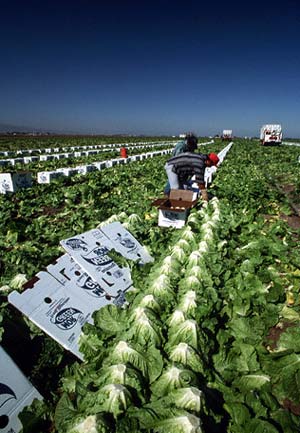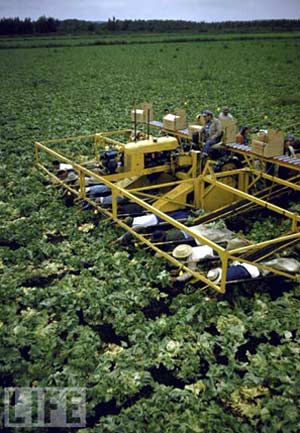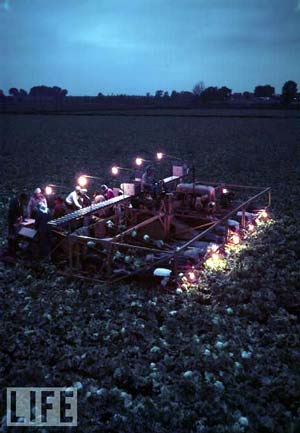|
There are moves by large processors, the food service sector and some retailers to supplement Australian produce with imports, taking advantage of better pricing and to hedge the risk of shortages in domestic supply.
Growers will need to vastly improve their handling techniques, internal cost structures and negotiating skills to deal with these changes,
The following report reviews the current status of mechanical harvesting and defines the crops that would benefit the greatest from the introduction of mechanical harvesting, including :
- existing mechanical harvesting techniques and practices
- adoption of mechanical harvesting in the Australian vegetable supply chain
- issues of technology impact on supply chains
- barriers to adoption of technology including capital costs and needs for change.
In addition the report includes a systems analysis for selected crops that would incorporate the impact of mechanical harvesting on agronomic practices, biomass handling, post harvest care, packaging, processing and the use of intelligent films for packaging.
This includes capital expenditure and impacts that will require production system changes or adjustments. A number of Industry Issues common to the regions are reported for the purposes of removing barriers to industry technology adoption.


Summary :
Growth and margin in traditional processed vegetables is low, 2-3% value and 1% in volume and is not seen as an area where consumer demand can be stimulated.
Processors of frozen products have moved toward markets for frozen dinners containing vegetables where growth is significant in both value (30% per year) and volume (25% per year).
Growers, in order to compete with this directional change, will need to vastly improve their handling techniques, internal cost structures and negotiating skills.
This includes the obvious move to greater mechanization using machinery, robotics, more sophisticated grading and packing equipment, HACCP elements, a reduction in handling and greater on farm processing in order to bring better farm gate returns.
Adoption of mechanical harvesting has primarily been for mature crops such as peas, beans, potatoes, onions and carrots.
Entrepreneurial Growers have invented mechanical harvesters for broccoli, leeks and lettuce while others are currently engaged in development of harvesters for leafy vegetables, celery and cauliflower.
Currently there are two development platforms for mechanical harvesters :
- The first and most common is a system that harvests all of the biomass and allows the grading and further processing to be made off-field.
Examples of this platform are those being used for broccoli, leeks, onions, lettuce, carrots and potatoes.
- The second platform is not widespread but is under serious development.
It uses sensing devices to determine fitness for purpose of plants for harvest, sophisticated cutting and in field processing.
Examples of this selective harvesting platform are being developed for lettuce and cauliflower.
Crops considered for investment in mechanical harvesting included Asian Vegetables, Celery, Cauliflower, leafy salad, Tomato, Wongbok and Zucchini.
Barriers to adoption of new technologies were considered to be :
- lack of understanding of the need to be internationally competitive
- removal of extension support by governments
- lack of co-ordination of R&D activities with extension
- diffusion forces across the industry sector
- the high risk associated with development at a farm level.

Conclusions:
-
Retailers were driving the agenda with respect to farm gate returns and as part of their process were reducing the number of suppliers to gain efficiency of delivery and all year supply capability.
-
Processors were locked into mature markets with low growth and margin and only through new levels of convenience were they able to increase the growth rate. Hence Processors were under pressure to compete using imported vegetables rather than local sources that lacked competitive pricing.
-
Consumers were looking for convenience, freshness and consistency of quality and price over the year.
-
Loss of export markets had occurred as a result of declining competitive position for some crops and the emergence of low cost Chinese product in Asia.
-
Growers were generally unaware of the cost structure required to make them internationally competitive. The competitor was seen as other local or regional Growers rather than international suppliers.
-
Growers were aware of automation technologies but had not related the use of these to horticulture.
-
Leading Growers had developed mechanical harvesters and achieved considerable cost reductions through labour saving. There was virtually no diffusion of these technologies across the industry.
-
Imported mechanical harvesters were used in a range of crops that tended to be in more mature markets such as onions, carrots and potatoes and hence the gains had already been made.
-
Mechanical Harvesting offers solutions to the sourcing of quality labour and removes many of the costs of labour. Overall reductions would vary with the type of crop and collectively would deliver between $60 and $100 million/year to farm gate returns from labour cost reductions and increased production of marketable products.
-
Mechanical harvesting is not a stand alone proposition as the agronomic practices, harvesting, materials handling, minimal processing, supply logistics and marketing activities need to be treated as a complete system and R&D applied to every component of the system.
-
Research and Development has generally been project oriented with emphasis on farm production and not system focused to achieve reduced costs, higher productivity and net market returns.
-
Future R&D aimed at creating international competitiveness should be assessed by a broader based process having full chain expertise to ensure all parts of the supply system are included and coordinated.
-
Future R&D in mechanical harvesting should be conducted by consortia having a range of expertise to address the needs of a total system rather than individual projects within a system.
-
Extension capacity has been reduced as government services have been withdrawn and this important role may need to be expanded by AUSVEG.
-
International benchmarking studies should become a regular feature for Growers, Equipment Suppliers and Manufacturers, extension and marketing persons. These studies need to provide quantifiable targets for productivity and qualitative information on trends in various marketplaces.
-
Growers and Grower/Processors need to have increased skills in marketing and negotiation in order to keep the gains of increasing mechanization and automation at the farm gate and not allow them to be usurped by retailers and multi national processors.
-
Potential emerging markets in plant extracts for use as ingredients in polymers, functional foods, cosmetics, cosmeceuticals, nutraceuticals and pharmaceuticals provide mechanisms for Growers to reduce dependency on traditional fresh and processed vegetable sectors.

Acknowledgements :
The author wishes to acknowledge the considerable assistance provided by the :
- Industry Development Officers
- AusVeg management and staff
- Government staff in primary industries
- Growers who attended the information sessions and provided follow up information
- Grower Processors who provided one on one sessions and insight into industry operations
- Major Processors who provided a manufacturing perspective on the national and international competitiveness of the industry
- Buyers of the Retail chains and Food Service distribution.
- Celect Management for assistance with the marketing analysis
This project was funded by Horticulture Australia through the National Vegetable R&D Levy.
The Australian Government provides matched funding for all HAL’s R&D activities.
|



